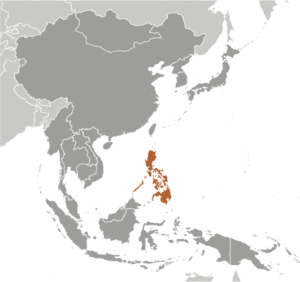There are a bunch of terms that relate to the Philippines, its language and its people. These are:
- Tagalog
- Filipino
- Filipina
- Filipinas
- Pilipino
- Pinoy
- Pinay
- Pinas
- the Philippines,
- Philippines, and
- Philippine
Believe it or not, each of these words is listed above is different. Some have more than two meanings.
You might have even read the words “Philippino” or “Philippina.” These words are often muddled up.
Are they always used correctly? Nope.
Are they confusing? Yes they are.
Are they impossible to learn? No.
Can you year them now? Yes.
Filipino vs Tagalog
From this list above, the two words that often confound people that study the Philippines are “Filipino” and “Tagalog.” Both words are related to the Philippines and both can refer to a language.
Tagalog is the most commonly spoken language of the Philippines. The word “Tagalog” comes from “taga-ilog” or the language of “those near the river.”
While Tagalog can refer to the language, it can also refer to the Tagalog people, or people from the regions of the Philippines where Tagalog is the predominant vernacular (e.g. not Bisaya, Ilonggo or Ilocano).
So what the heck is “Filipino?” Well, it also refers to the language of the Philippines and it also refers to a person from the Philippines.
Say what?
In the 1930’s, the Philippine Constitution declared that there should be a national language which would unify the country. It was decided that Tagalog, the dialect in use in Manila and the nearby provinces, would form the base of a national language that would incorporate words from other provincial dialects.
Not wanting to offend other linguistic groups in the Philippines, like the Bisayas, Ilocanos and Illongos, the politicians decided that this national language would be called “Filipino.”
In school, people will call the subject that teaches this language “Filipino.” Because people don’t really follow their teachers and politicians outside the classroom, 9 times out of 10, if you ask a common person on the streets of the Philippines what language they are speaking, they’d say “Tagalog” and maybe 1 out of 10 times, they’d say “Filipino.”
So calling the language which is now spoken by the majority of the denizens of the Philippines “Filipino” never really caught on with normal folk. Officially though, that’s what you should call the language.
When talking about “Filipino” referring to a person, not the language, this is a general term you can use to refer to anyone from the entire country or archipelago (not just the snobbish Tagalogs up north in Manila).
Filipino vs Filipina
The word “Filipino” is a term that is used to describe someone from the Philippines, such as someone native in the region, or by citizenship or heritage. “Filipino” is a general term that can refer to any gender. However, if you are referring to a specific person, it is proper to call that person a “Filipina” if that person is female.
Note that “Filipino” and “Filipina” are English words and should used when the language being spoken is English.
For example: You can say that “I am a Filipino.”
If you are a woman, you say “I am Filipina.”
Pilipino and Pilipina
When speaking Tagalog, it is more corrected to use the Tagalog equivalents “Pilipino” which is the Tagalog for the English word “Filipino” or someone from the Philippines.
Meanwhile, the word “Pilipina ” is the Tagalog word for “Filipina” meaning someone from the Philippines.
For example: You can say that “Pilipino ako.”
If you are a woman, you say “Pilipina ako.”
However, don’t be surprised if you hear “Pilipino” or “Pilipina” and instead of their English equivalents, or vice versa, as both are widely-acceptable in everyday speech.
That would mean “Filipino ako.” is wrong if you’re strict about, but no one would really notice.
Also, don’t be confused because the word “Filipino” can also refer to the Tagalog language as discussed above, or more precisely, one of two the mandated national languages of the Philippines (the other being English).
The Philippines
When referring to the country remember to always append the word “the” before “Philippines.” It should almost always be the “the Philippines.”
Wrong: “I am going to Philippines.”
Correct: “I am going to the Philippines.”
This is similar with other countries or places that are made of islands or , like “the Maldives” or “the Solomon Islands.”
This is the same grammatical rules as countries like “the Netherlands.”
The full name of the country is “The Republic of the Philippines.” Of course, 99.98% of the time “the Philippines” is sufficient to refer to the country.
Philippines
You may see the word “Philippines” without the word “the” but this is usually in combination of other words. The word “Philippines” will be at the end to represent the country. This is usually where the word “the” would be awkward. For example, “Teen Model Philippines”, “NBA Philippines”, or “Birdwatching Club Philippines.”
Pilipinas
The Tagalog equivalent of “the Philippines” is “Pilipinas.” If you are referring to the country in Tagalog use “Pilipinas.”
For example: “Pupunta akong Pilipinas.”
This means: “I’m going to the Philippines.”
Philippine
The word “Philippine” is an English used when the word is used as an adjective to describe something that has the characteristics of the Philippines
For example, “Philippine culture” or a “Philippine mangoes.”
You can also say someone has “Philippine citizenship.”
Here, it’s okay to drop the word “the.”
Alternatively, the word “Filipino” can also be used as an adjective to refer to the Philippines in loose, colloquial use, such as “Filipino culture” or “Filipino mangoes.”
You can even say someone has “Filipino citizenship” and that, while not technically correct, would be absolutely acceptable in everyday speech.
Pinas
The word “Pinas” is the shortened version of “Pilipinas” which is the Tagalog word for “the Philippines.”
Its use is colloquial but understood by all. For example, I can say “Gusto ko nang umuwi ng Pinas.” meaning “I really want to go home to the Philippines.”
By using the word “Pinas” to refer the country connotes a closeness and intimacy to Philippine culture.
Pinoy
A “Pinoy” is a colloquial version of “Filipino.”
That means a person can be a “Pinoy.”
You can for example say “Pinoy ako.”
However, because the word is colloquial, it connotes a familiarity or closeness to the culture.
Like the word “Filipino” you can also use “Pinoy” as an adjective.
For example you can say some is “pinoy na pinoy” or very Filipino, such as a dish that has no foreign influence.
Pinay
Pinay is a colloquial version of the word “Filipina.”
Like “Pinoy” it connotes an intimacy to the culture.
And like the word “Filipina,” it can refer to both a person or to a quality, though it refers to the traditional feminine culture of the Philippines, such as beauty or fashion.
For example, I can exclaim a traditional Philippine dress is very “Pinay.”
I can also say that a woman is “pinay na pinay ang beauty” meaning her beauty is that of a traditional Filipina (person of the Philippines), meaning there is no trace of foreign heritage in her looks.
“Philipino”
Do not ever use or write the word “Philipino.” It simply does not exist and it sounds very awkward to a native Tagalog speaker. Remember part of flirting is showing of your education and culturedness. While it might not matter much in the long run, the word “Philipino” definitely “hurts the eyes” of native Tagalog speaker.
“Philipinas”
This is another word that is like “Philipino.” It is wrong and should not be used. “Philipina” and “Philipinas” and its ilk belongs in the linguistic trash can.
Closing words
I hope this didn’t leave you more confused than enlightened. I might have, but hey, I’m not making this stuff up.
Anyway, if you make a mistake, you’ll probably be forgiven for it. Some people might even think it’s a cute foreigner thing.
So don’t let this bother you. Just keep plugging away at learning Tagalog, err… Filipino, and everything should go well.



By watching Pinoy Teleserye can we learn/understand this language?
Exposure always helps!